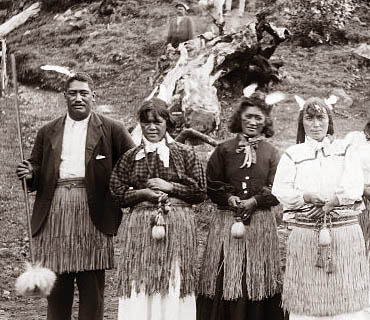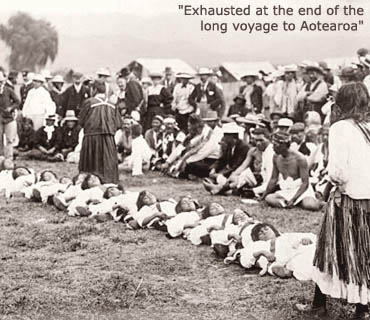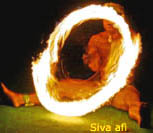NZ FOLK*SONG >> Waiata >> Pakete Whero >> The History of Poi
|
The word poi refers to a Maori dance or game performed with a ball-like object, to which a cord of varying length is attached. Poi refers to both the ball and the dance, which normally includes hitting and swinging the ball on its string, usually accompanied by music or a chant of some kind.
Precursors
of Poi in Polynesia
Juggling oranges Tonga 1900Karyn Paringatai (2004 Poi thesis.pdf) has identified ball games from islands throughout Polynesia similar to those of poi.In Samoa and Tonga juggling oranges was a pastime of the virgin daughters of chiefs.
On Wallis Island juggling with oranges is still an amusement for young girls. The motions are made in time to a little song. (Burrows)
In Tahiti pei is "an amusement in which stones or limes are thrown and caught" (Davies). In the southern Cook Islands ball tossing or juggling is known as pe'i. The 'balls' are either the fruit of the candlenut tree, or more commonly oranges. (Buck)
Wrist exercise in Aotearoa
In the tropical Pacific Islands, clothing was made quickly by beating out mulberry bark to form tapa cloth. But warmer clothing was needed in the colder climate of Aotearoa. Many hundreds of hours had to be put into making thick cloaks out of finely woven flax fibres. Their aching wrists (and numbed minds) needed relief.
Maori carried moa eggs in small woven flax "kii" hung around their body with cords. Warriors or "toa" put weights in the kii to make "kiitoa" that they swung to build up wrist strength and flexibility for combat with hand weapons.With softer and lighter filling, these kiitoa were also used by women for wrist exercise, to prevent carpel tunnel syndrome when weaving cloaks. (Hemana)
A spiritual journey in Taranaki
Taranaki people say that poi as a game started in Aotearoa at Opunake.
"A girl named Pari was getting raupo in a swamp. She worked some of it into balls for amusement and when she heard the other girls singing she would juggle these balls about in time to the music. The word poi once meant singing, and this new game was called poi because it went with singing. Pari's father commanded her to show this entertainment at a big gathering and gradually made its way all over New Zealand" (Beattie)Poi performances were used to take the performers and audience on a spiritual journey."Poia atu taku poi, wania atu taku poi."
Swing far my poi, skim onward my poi.These are the age-old words used in poi compositions to send the poi on a figurative journey over the land and its people; visiting mountains, rivers, forests, villages, whānau families, hapū clans, and iwi tribes. The words demonstrate how important these are for the poi's composer and performers.
Peace and Hospitality at Parihaka
In the 1800s, religious use of poi by the prophet Te Whiti at Parihaka dissuaded other tribes from using it as an item of entertainment for Pākehā who were oppressing this peaceful Taranaki settlement. The Parihaka movement was underpinned by
- the Bible (the supreme word of God),
- the raukura, (three white albatross feathers denoting glory to God, peace on earth and goodwill to all men)
- the poi (an irrepressible free spirit).
Te Whiti's liturgy was a large body of poi songs that greatly impressed James Cowan:
"The women and girls, numbering about thirty . . . chanted and swung the poi, and swayed their supple forms for nearly two hours . . . There was something almost fierce about the delivery of this kind of poi, the flashing black eyes, the wild high chant, that combined to give a thrill that the ordinary poi of the Maori amusement halls does not hold."
"Peace, goodwill and hospitality." Raukawa and poi at Parihaka in 1898.
Entertaining Tourists in the Bay
However, other tribes began using poi performances as a vivid reminder to Pakeha of their ownership to the land. When Lord Ranfurly visited Ruātoki in March 1904, Ngāi Tūhoe performed a poi waka (a boat poi) to tell the story of how Polynesian voyagers came to Aotearoa and claimed the land as their own. It was one of the main attractions of the visit.
Poi waka then returned to the tourist circuit, and became modified as the Whakarewarewa guides polished up their concert performance parties to earn a higher income.
Guide Bella Papakura in particular quickly took poi to new levels of performance, mixing traditional conventions with modern practices, and in doing so she created styles that quickly became widespread.
The most famous waka poi was Tomoana's Hoea Ra Te Waka Nei. It was performed in cities in 1917 to raise money for Maori soldiers fighting in World War One, and the poi told of the fear of the performers as the balls became fluttering fantail messenger telegrams notifying the deaths of loved ones.
Circles of fire around the world
Waiata




